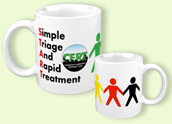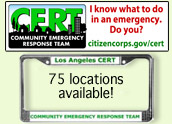Natural Disasters and Other Risks
| Africanized Honey Bees | Africanized Honey Bees Also available in Spanish. |
Emergency Survival Program |
| Blackouts | Fact Sheet: Safety Information for Short-Term Power Outages or “Rolling Blackouts” | American Red Cross |
| Rotating Electric Outages: Safety and Conservation Tips | Los Angeles County Office of Emergency Management | |
| Drought | Drought Fact Sheet - Water Conservation | American Red Cross |
| Earthquakes | The Great East Japan Earthquake and Tsunami | LAFD Battalion 14 ACS |
| EARTHQUAKE COUNTRY ALLIANCE The Earthquake Country Alliance unites leaders in government, disaster response, science, business, media, education and local communities to raise earthquake awareness and reduce losses in future earthquakes. This website includes videos, brochures, how-to information, resources in Spanish, and answers to frequently asked questions. |
Earthquake Country Alliance | |
| DARE TO PREPARE Earthquake professionals, business and community leaders, emergency managers, and others have organized the "Dare to Prepare" campaign to raise earthquake awareness and encourage earthquake readiness in southern California. The main message of the campaign is that if you "Secure Your Space" before our next big earthquake you can protect yourself, your family, and your property. This website includes how-to instructions for how to secure your space, videos, animations, and other resources. Also available in Spanish at http://www.earthquake country.info/terremotos/: Los residentes de habla hispana del sur de California encontrarán aquí información científica sobre los terremotos y consejos prácticos sobre cómo prepararse, como parte de la campaña "Dare to Prepare". Esta campaña está uniendo a la comunidad del sur de California para "hablar de nuestras fallas" y prepararnos juntos antes de futuros terremotos. |
Earthquake Country Alliance | |
| PUTTING DOWN ROOTS IN EARTHQUAKE COUNTRY This popular 32-page earthquake science and preparedness handbook was first published in 1995 by the Southern California Earthquake Center. SCEC and the Earthquake Country Alliance now update the handbook yearly, and it is now available in both English and Spanish. The handbook features current scientific understanding of when and where earthquakes will occur in Southern California, how the ground will shake as a result, and the Seven Steps to Earthquake Safety. Putting Down Roots in Earthquake Country can be read online, downloaded or you can request free copies. It is available in English and Spanish. |
Earthquake County Alliance | |
10.5 MINISERIES ON NBC |
Earthquake Country Alliance | |
| TRIANGLE OF LIFE? An email from Doug Copp, titled "Triangle of Life," is making its rounds again on the Internet. Mr. Copp's assertion in his message that everyone is always crushed if they get under something is incorrect. "Drop, Cover, and Hold On" is CORRECT, ACCURATE, and APPROPRIATE for use in the United States for earthquake safety. Please advise people that they MUST consider the source of information before they change emergency procedures at work and at home. If information does not come from a trusted source such as local fire and law enforcement agencies, the California Office of Emergency Management, County Office of Emergency Management, County Office of Education, city offices of Emergency Management, FEMA, or the American Red Cross, then they should be highly skeptical about the truth of what they are reading. The Earthquake Country Alliance has set up a special web page which has links to statements and rebuttals from many preparedness organizations, as well as newspaper articles about the "Triangle of Life" and its advocate. |
Earthquake Country Alliance | |
| Recently, members of the general public and other California Emergency Management Agency constituents may have received information via email and other sources
promoting a protective measure called the "triangle of life" and questioning the "duck, cover and hold on" procedure recommended for use during earthquakes here in California and in other areas of the United States. Because buildings constructed in California and the United States are built to much stricter codes and standards than those in other countries, including Mexico, Iran and Turkey, collapses here are very rare. Extensive research into the causes of earthquake injuries and deaths supports the use of the Duck Cover and Hold procedure recommended by CalEMA, the California Seismic Safety Commission and the American Red Cross. Most injuries in California earthquakes occur when building occupants attempt to exit buildings or move to a different location in the building. In the 2003 San Simeon earthquake, two people were crushed by falling debris when they exited the building. Studies of the 1979 El Centro, 1987 Whittier, 1989 Loma Prieta and 1994 Northridge earthquakes confirm this pattern of injuries, and that use of the Duck, Cover and Hold On procedure reduces the likelihood of serious injury from a collapsed building and falling objects. After each disaster, CalEMA attempts to learn from behavioral research and other studies, and apply lessons learned into safety action recommendations. There is, of course, no guarantee that people will not be injured in an earthquake. Earthquakes can shake buildings violently and cause extensive damage. The key to injury prevention is making sure buildings are safe, contents are secured, and occupants are trained to duck cover and hold. Please share this information as appropriate and feel free to contact the CalEMA Office of Public Information at (916) 845-845-8510 if you have any questions or need additional information. |
California Emergency Management Agency | |
| Earthquakes: Fact or Fiction | Emergency Survival Program | |
| Earthquake Safety Checklist Also available in Chinese - Traditional, Chinese - Simplified, Japanese, Korean, Spanish, Tagalog, and Vietnamese. | FEMA | |
| 27 Things to Help You Survive an Earthquake Also available in Arabic, Cambodian, Chinese, Farsi, Japanese, Korean, Spanish, Tagalog, and Vietnamese. | American Red Cross | |
| Are You Ready For An Earthquake? Also available in Spanish | American Red Cross | |
| Avoiding Earthquake Damage | FEMA - Federal Emergency Management Agency | |
| Beat the Quake Also available in Cambodian, Chinese, Hmong, Korean, Laotian, Spanish, Tagalog and Vietnamese. |
American Red Cross | |
| Duck, Cover and Hold Drill | California Emergency Management Agency | |
| Earthquake Safety Information Also available in Cambodian, Chinese, Hmong, Korean, Laotian, Spanish, Tagalog and Vietnamese. |
California Emergency Management Agency | |
| Earthquake Safety Tips for Elderly People | American Red Cross | |
| Earthquakes |
Emergency Survival Program | |
| Earthquakes | FEMA - Federal Emergency Management Agency | |
| Ever Wonder What Causes Earthquakes? | California Emergency Management Agency | |
| How to Strap Your Water Heater | California Emergency Management Agency | |
| How to Secure Your Furniture | California Emergency Management Agency | |
| How You Can Strengthen Your Home for the Next Big Earthquake in the Los Angeles Area | Los Angeles Department of Building and Safety | |
| Homeowner's Guide to Earthquake Safety Also available in Spanish. |
California Seismic Safety Commission | |
| Preparing Children for Earthquakes | California Emergency Management Agency | |
| Preparing Your Family | California Emergency Management Agency | |
| Tips for Pet Owners | California Emergency Management Agency | |
| Tips for Apartment and Mobile Home Managers | California Emergency Management Agency | |
| Tips for the Physically Challenged | California Emergency Management Agency | |
| What to do Before, During, and After an Earthquake Also available in Spanish | California Emergency Management Agency | |
| Fire and Wildfire | ESP Bulletin on Wildfires | Emergency Survival Program |
| Are You Ready for a Fire? Also available in Spanish | U.S. Fire Administration | |
| Fire Safety Checklist for Older Adults | U.S. Fire Administration | |
| Protecting Your Family from Fire | FEMA - Federal Emergency Management Agency | |
| Are You Ready for a Wildfire? | American Red Cross | |
| Wildfire - Are You Prepared? | American Red Cross | |
| Wildfires | Emergency Survival Program | |
| Flood | After a Flood - The First Steps | American Red Cross |
| Are You Ready for a Flood or Flash Flood? Also available in Spanish |
American Red Cross | |
| Flash Floods and Floods - The Awesome Power | National Oceanic and Atmospheric Administration | |
| Floods | Emergency Survival Program | |
| Floods | FEMA - Federal Emergency Management Agency | |
| Homeowner's Guide for Flood, Storm Debris and Erosion Control Updated! This has a page on sandbagging. |
Los Angeles Department of Building and Safety |
|
| Repairing Your Flooded Home | American Red Cross | |
| Your Home Has Been Flooded - The First Steps | American Red Cross | |
| Flu, Pandemic and Avian | One-stop access to U.S. Government avian and pandemic flu information. | Department of Health and Human Services |
| Hazardous Materials in the Home | Household Hazardous Materials - A Guide for Citizens This course is available on-line as an interactive web-based course. |
Emergency Management Institute |
| Hazardous Materials |
Emergency Survival Program |
|
| Heat Wave | Are You Ready for a Heat Wave? Also available in Spanish |
American Red Cross |
| Extreme Heat and Emergency Water Shortages | FEMA - Federal Emergency Management Agency | |
| Heat Wave |
Emergency Survival Program | |
| Hurricane | Against the Wind - Protecting Your Home from Hurricane Wind Damage | FEMA - Federal Emergency Management Agency |
| Are You Ready for a Hurricane? Also available in Spanish |
American Red Cross | |
| Hurricanes - Unleashing Nature's Fury | National Oceanic and Atmospheric Administration | |
| Hurricanes | FEMA - Federal Emergency Management Agency | |
| Landslides | Landslide and Debris Flow | FEMA - Federal Emergency Management Agency |
| Landslides and Mudslides | Emergency Survival Program | |
| Public Health | Public Health Emergencies |
Emergency Survival Program |
| Storms/Tornadoes | Are You Ready for a Thunderstorm? Also available in Spanish |
American Red Cross |
| Are You Ready for a Tornado? Also available in Spanish |
American Red Cross | |
| Thunderstorms | FEMA - Federal Emergency Management Agency | |
| Windstorms and Tornadoes Also available in Spanish. |
Emergency Survival Program | |
| Tsunami | Are You Ready for a Tsunami? | American Red Cross |
| Tsunamis | FEMA - Federal Emergency Management Agency | |
| Be Aware - Tsunamis | Emergency Survival Program | |
| Volcano | Are You Ready for a Volcano? | American Red Cross |
| Volcano Safety Information Fact Sheet | American Red Cross | |
| Volcanoes Also available in Spanish. |
Emergency Survival Program | |
| Winter Storm | Are You Ready for a Winter Storm? Also available in Spanish |
American Red Cross |
| Cold Weather |
Emergency Survival Program | |
| Winter Storms - The Deceptive Killers | National Oceanic and Atmospheric Administration | |
| Winter Storms and Extreme Cold | FEMA - Federal Emergency Management Agency |













